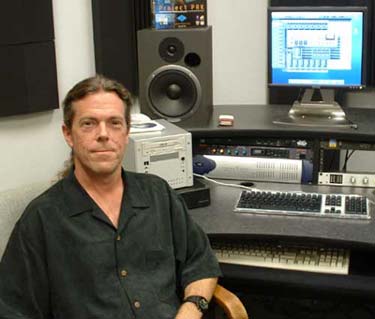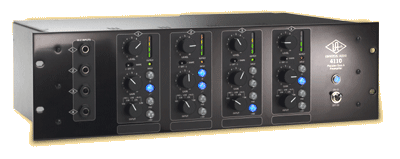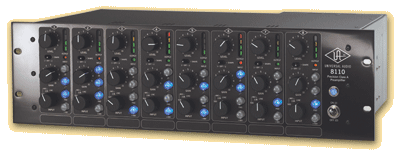Universal Audio WebZine
Volume 2, Number 10, December 2004
[UA Universe] [Ask the Doctors] [Digital Minds] [Analog Obsession]
[Support Report] [The Channel] [Plug-In Power] [Analog Ears] [Featured Promotion]
[Graphic-Rich WebZine]
[Back Issues] [UA Home]
Volume 2, Number 10, December 2004
[UA Universe] [Ask the Doctors] [Digital Minds] [Analog Obsession]
[Support Report] [The Channel] [Plug-In Power] [Analog Ears] [Featured Promotion]
[Graphic-Rich WebZine]
[Back Issues] [UA Home]
Ask The Doctors
This month we'll discuss some aspects of the new 8110 and 4110 microphone preamps.
 |
|
Joe Bryan
|
What were the design goals for the 8110 and 4110 preamps?
Joe: Mic preamps are like shoes for people with shoe fetishes: You can't have enough of them. They all sound different, and the combinations of mic, preamp and sound source all interact to give each combination its own appeal in different applications. Even though UA already makes several different mic preamps, we wanted to offer something that had a broader range of sounds so it would be especially appealing as a multi-channel unit. Most multi-channel preamps are very limited, because even though you get a lot of channels, they all have the same sound. We wanted to build a preamp that provided maximum sonic flexibility without compromise.
“Most multi-channel preamps are very limited, because even though you get a lot of channels, they all have the same sound. We wanted to build a preamp that provided maximum sonic flexibility without compromise.”
Rich: Universal Audio has always made mic pres with great character, and we needed something that would compliment these, but offer state-of-the-art clarity.
My goal when I set out to design the 4110 and 8110 was to introduce a mic pre that delivers uncompromised dynamics and clarity while still sounding warm and friendly. When checking out other high end, solid-state pres, I found them to be rather stark and empty sounding. I wanted something that better complimented the recorded material. I knew an all-discrete, class-A, direct-coupled circuit path was the way to go, but how do you get that special something that sets it apart?
When I got into the nitty gritty of the design, I found that different parts of the circuit could be varied to give differing distortion characteristics (aka warmth), and differing clarity. It was hard to choose exactly which characteristic was best suited for general use, since there is no such thing as "general use" in the studio. Every pre and every mic has a particular sound that is best suited for particular applications. Therefore we decided to make these characteristics user selectable.
 |
|
Rich Williams at the helm of Paradise Recording
|
Joe: The 8110 and 4110 preamps provide several features that are not available elsewhere.
First, they have a very flexible input circuit that provides ultra-high quality transformer-coupled mic and line inputs with selectable mic impedance and pad, and the 4110 provides a dual-impedance instrument input that bypasses the transformer. The impedance options alone provide a wide range of tone options.
Second, the preamps use a two-stage variable-gain structure that provides total control over the relative harmonic level and signal level. The 8110 and 4110 provide up to 80 dB of gain, a maximum output level of +30dBu and can handle very high input levels, so there's plenty of room to allow tailoring the gain structure to get exactly the sound you want-from ultra-clean to warm and colorful.
Third, the signal path from the input circuit to the DC-coupled, auto-balanced line output is comprised of three different all-discrete, class-A biased, DC-coupled matched-FET and bipolar transistor amplifier designs, each built with the absolute best components available using low-reactance, wide-bandwidth layout techniques. There are no capacitors in the signal path, and the internal impedances are as low as possible for maximum dynamic range, minimum noise, and fast transient response. Every channel has its own multi-stage regulated power supply for maximum channel separation and ultra-tight low-end. Each channel also has switchable phantom power, phase reverse, and low-cut filter.
Rich: It's all about the sound and musicality. I've always admired the fact that Bill Putnam Sr. was such a talented and innovative recording and design engineer and I know that my own experience as a recording engineer has had a huge impact and influence on my design work. The 4110 and 8110 mic pres, just like the 2192 converter, were designed in the studio, not just in the lab. I've been running sessions here at Paradise Recording with x110 prototypes sitting next to me with wires sticking out everywhere, trimming the bias currents, tweaking impedances, and modifying the circuit to get the absolute best possible range of sounds for almost a year now. I have used them on a wide range of instruments, including drums and percussion, bass, guitar amps, acoustic guitars, vocals, and horns, and I've found they sound great in nearly every situation delivering outstanding clarity, dynamics and warmth.
 |
 |
Joe: We also made sure they work reliably, day in and day out, and we went to great lengths to make them look as nice as possible. Like any great performer, a nice presentation is part of the deal. Rich made a box with a cool paint job for the first proto, which has become known as the Magic-Bus version. We thought about hiring some local Santa Cruz stoners to make custom paint jobs for each unit, but realized they'd just end up huffing fumes all day.
Joe: While Rich was tweaking and twiddling the prototypes, he discovered some interesting circuit variations that really changed the character of the preamps. After everyone had a chance to listen to them, we decided we liked them all, so we put a switch on the front panel to allow making these changes easily. At first we couldn't figure out what to call it, but settled on "Shape" as the best option.
What Shape does is allow setting each channel to one of three different characters: "Clean", "Vintage" and "Saturate.". The "Clean" setting provides maximum transparency, bandwidth and headroom, with minimal color. The
 |
|
The Magic Bus - the original hand painted x110 prototype by Rich
|
Rich: One of the things I found was missing with the other "in vogue" pres is the lack of separate gain and level controls. You just get one knob, so you can never really hit the rails without the output level being way too loud. With the 4110 and 8110, you can use the gain knob to get up close to the rails, while keeping your output level manageable with the level knob. That's where you get a lot of character, and that's also why we offer a line input. When you run prerecorded material back through the line input and "jack" the gain, you can really bring things alive! The variable gain coupled with the shape switch and impedance selection, gives the engineer a wide pallet from which to work with. This is what sets the 4110 and 8110 apart from the competition.
For more information, see the 8110 and 4110 product pages.